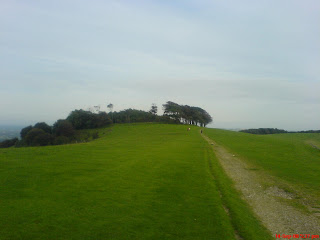 |
| Chanctonbury Ring from the west |
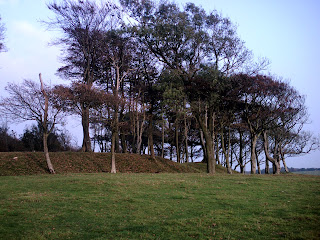 |
| Chanctonbury Ring - close up |
Chanctonbury Ring is unfailingly beautiful and represents the ultimate appeal of this gentle range of hills, the South Downs, stretching from Winchester to Eastbourne; as well as the 360 degree views, it has a full flush of components to make it a complete weekend walking excursion: rolling down-land, patchwork quilt countryside below, a choice of ascent, notably from the A23 to the west, or the A283 to the north, the most popular route; cosied up against the northern foot of the scarp slope is Wilton Park, with its stately home, Wiston House, used by the government for important conferences; drop down to the north west and you immediately fall upon the watering hole of the Frankland Arms in the backwater village of Washington. This 200 year-old coaching inn was used by Dave Allen, the comedian, for a number of his sketches inside the pub and on the downs.
Ring has clear associations with antiquity. Over 3500 years ago during the Bronze Age a young woman with a bronze dagger was buried near the spot. A thousand years later, during the Iron Age, a hill fort was built there. About 350 years AD, a temple was built inside the earthworks; the evidence is that the temple was used for a mixture of British and Roman beliefs. It is possible that it was a temple to Mithras, the early Persian God who the Romans worshipped. Numerous Roman and Anglo Saxon coins have been discovered on the summit over the years, some dating from the time of the Emperor Nero. One labourer boasted of selling one single coin to a gentleman for about a year’s wages! There are a number of tumuli (ancient burial mounds) spaced along the ridge. In 1588, a defining moment in British history, beacons were lit on the Ring to warn of the Spanish Armada, when Philip II of Spain tried to take England. Again in 1805, when England faced the Napoleonic threat, the Ring was marked out as a beacon station.
The track from the north can be accessed by taking the A283 Washington to Steyning road from the west; just before the entrance to Wiston House and park a lane nicks off to the right as the route to Chanctonbury. By driving up this lane a few hundred yards a car park is reached, from whence you can walk a little further up the lane which gives way to a jagged bosted track that winds up through thickly forested scarp slopes until open down-land is found at the top, where the South Downs Way follows the hill line east-west. This famous walking route stretches 80 miles from Beachy Head in the east to the Hampshire border. By following the track gently upwards through a gate and on over the back of the downs, you reach Chanctonbury Ring, 783ft above sea level.
Alternatively you can take the dog’s leg road that cuts back parallel to the A24 from the village of Washington. Park up at the car park at the end of the lane and then take the track due east up the hill. This is a straightforward route impossible to lose that leads you up to the Ring. As you ascend the well-marked chalk track you might be lucky enough to witness a tiny plane take off from a standing start in one of the little folds of the Downs. Funnily enough, the vicinity has another association with aviation; in 1956 2 Sea Hawk jets were approaching Ford Naval Air Station from Lossiemouth. Sea mist covered the Downs at the time, and one aircraft disastrously hit the ground just southwest of the Ring; the other bounced and carried on to Ford for what must have been an interesting landing.
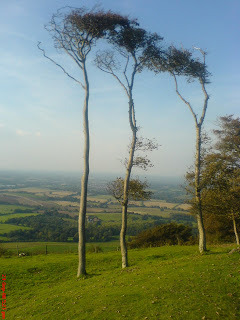 |
| View over Sussex Weald from the Ring |
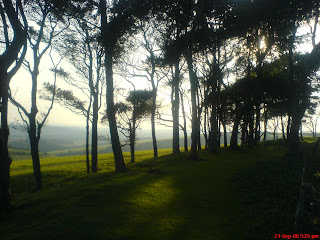 |
| View from the Ring |
This ring of trees on top of the downs was decimated in the October 1987 Great Storm, the biggest meteorological phenomenon to hit the UK in the twentieth century, when 100 mph plus winds hit the South of England. Indeed it was the worst storm in 300 years. From a distance it now appears in likeness to the remaining tuft of hair on a hirsute man; there was quite a bit more of that hair before the hurricane, when the 783 ft summit was crowned with beech trees. The trees had an interesting history, and were planted by a 20 year old young man named Charles Goring, the heir to the Wiston Estate, who rather upset the locals with his project who thought his project foolhardy and worried that the line of the Downs would be spoiled. He actually organised water to be carried up the hill to establish the saplings. Charles Goring obviously had a great love for his trees; on his gravestone in Wiston churchyard, overshadowed by a great yew is the following:
Would creep within my breast,
Oh! could I live to see thy top
In all it's beauty dress'd
That time's arrived; I've had my wish
And lived to eighty-five;
I'll thank my God who gave such grace
As long as ere I live.
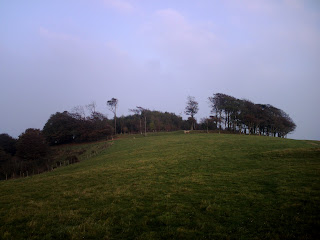 |
There are many pieces of lore connected with the Ring, the most famous being of a common type where the object is walked or run around. In the case of the Ring, if you walk (or run) seven times (sometimes running backwards or anti-clockwise) around it on a dark or moonless night (one account says Midsummer Eve at 7pm, another May Day Eve, another at midnight, during the time it takes a clock to strike midnight) without stopping, the devil will appear and offer you a bowl of milk, soup or porridge (reports vary). Some say that if you accept, he will take your soul, or grant you your dearest wish." It is also said that the devil was responsible for making the Ring, when he threw lumps of earth away as he built the Devil’s Dyke further along the downs near Brighton; other well known spots said to have originated in the same manner were Mount Caburn, Cissbury, Rachham Hill and the Isle of Wight! Another tale is that if you walk or run round the ring on Midsummers Eve at midnight, a druid’s apparition will appear and move towards you.
Witchcraft, UFO sightings, strange
presences, levitation, the loss of use of arms and legs. Not the sort of things
you would associate with the gentle South Downs of Southern England.
"Even on bright summer days
there is an uncanny sense of some unseen presence which seems to follow you
about. If you enter the dark wood you are conscious of something behind you.
When you stop, it stops; when you go on it follows”
In 1968 a group decided to do a
bit of UFO spotting on the Ring one night, and were “rewarded with a
sighting, along with waves of intense cold, a sensation of electric shock,
difficulty in breathing and stomach pains.” In 1972 3 people saw an object
brush the tree tops, large and glowing red. A minute later the object moved
away and the people saw blue lights and what seemed to be 4 windows on top of
the craft. Something of the same description was seen in 1979.
Stories of witchcraft are rife and sit snugly with all the other
associations of this famous beauty spot. Some kind of altar was found in 1979
in the form of a 5-pointed star of flints within a circle of flints; pieces of
thick parchment bearing candlewax were also found. Aleister Crowley, famous for
occult involvement, thought the Ring was a ‘Place of Power.’
Chanctonbury’s beech heritage is not lost; the Wiston estate,
still in the hands of the Goring family, planted 400 trees in February 1991
with financial help form the public and WSCC. A fence has been erected around
the trees to give protection.
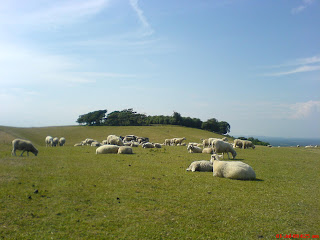 | ||
Chanctonbury Ring from the east
|

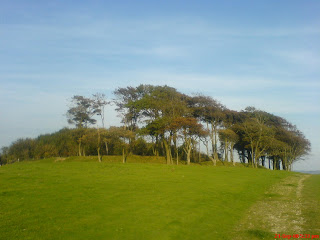
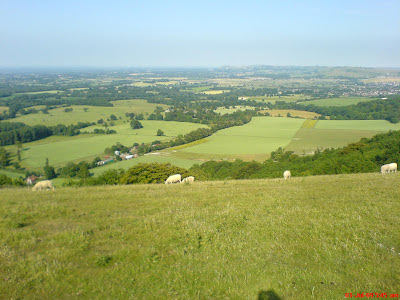
No comments:
Post a Comment